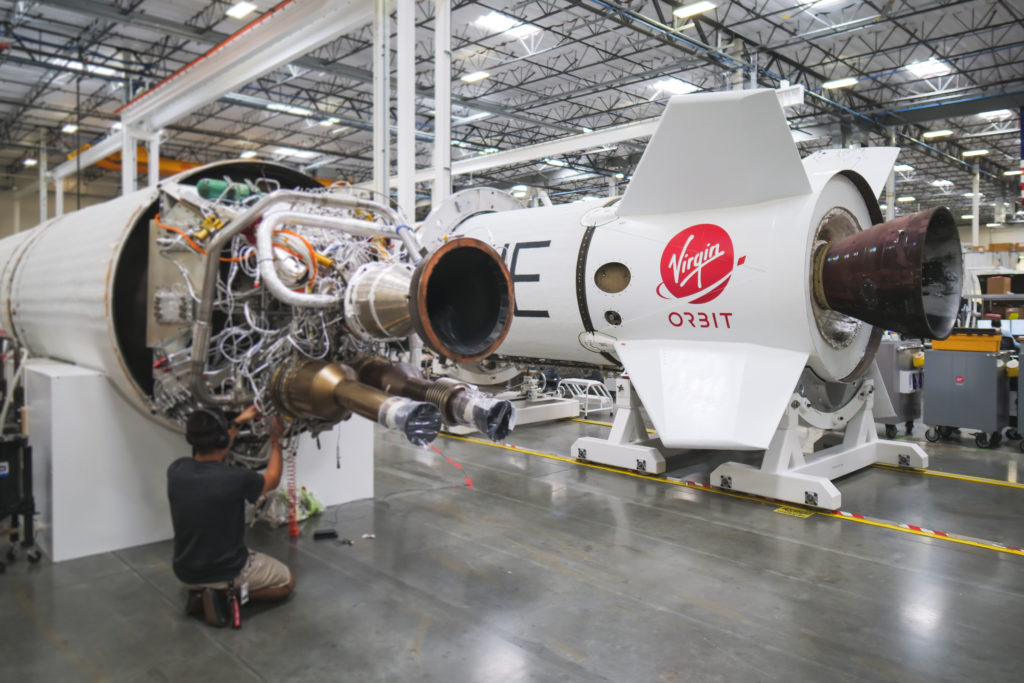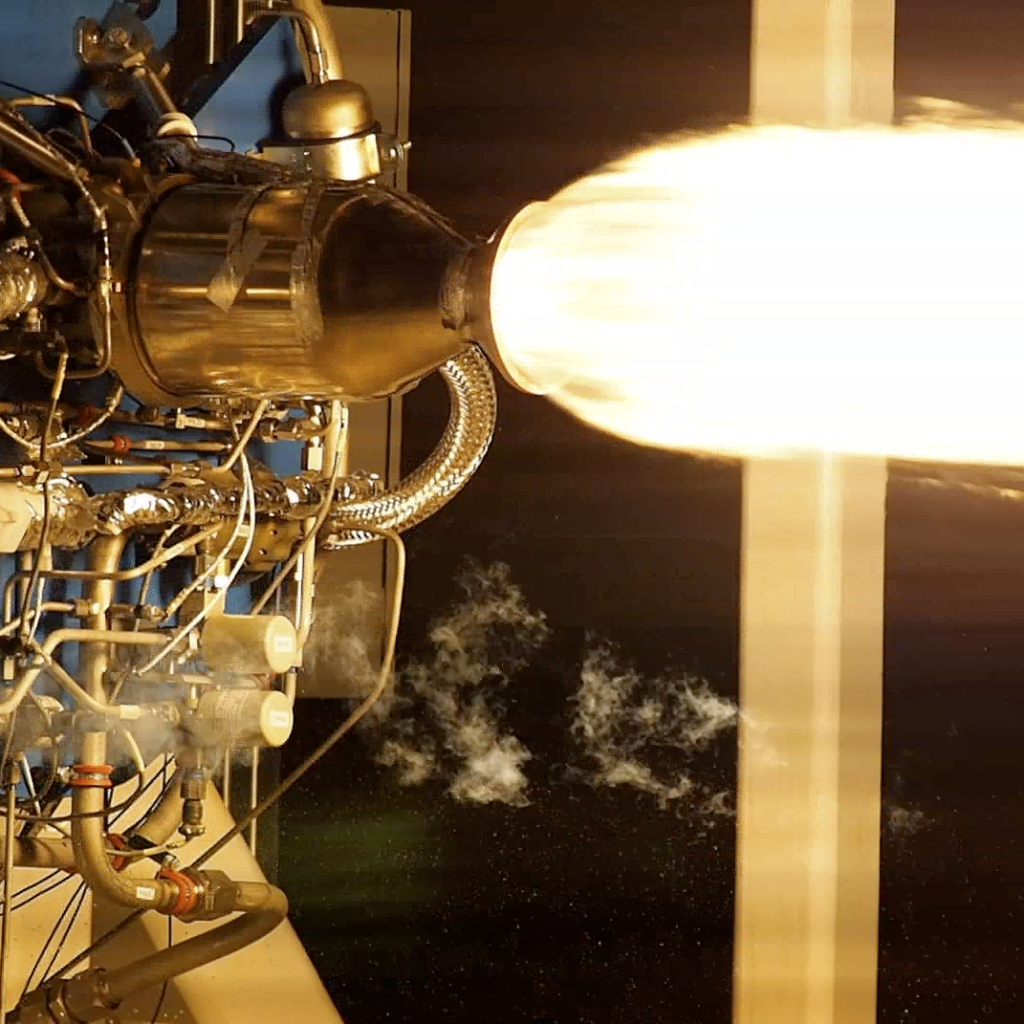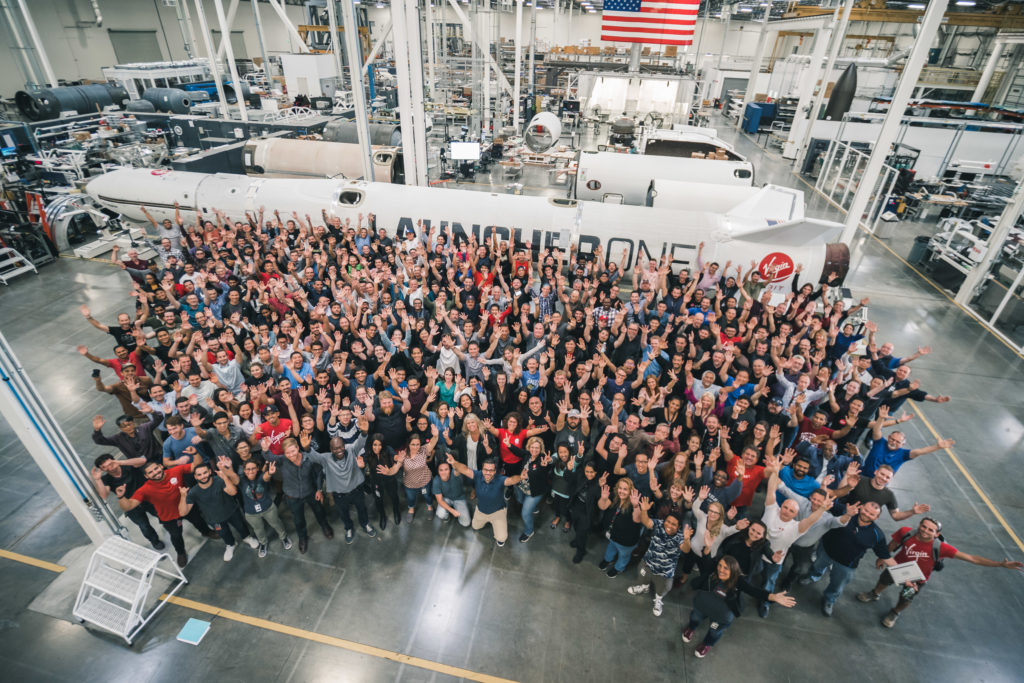 A rocket launched from Earth needs to reach a speed of at least 7.9 kilometers per second to get to space. That’s 20 times the speed of sound and six times faster than the speed of a Blackbird spy plane, the fastest aircraft of its kind. But rockets are not just about the speed, they need to withstand strong forces during launch, be as light as possible, and survive the journey in one piece. The makings of a rocket are quite complex, requiring thousands of parts to function, which is why private companies that have sprung in the last decade have turned to new technologies to make them. One of them is Virgin Orbit, a spinoff of Richard Branson’s Virgin Galactic, that is creating rockets for satellite launches to space using 3D printing technology. Branson, a British adventurer, philanthropist, and entrepreneur, has become the creative head of one of the largest aerospace conglomerates in the world, and a faithful supporter of additive manufacturing.
A rocket launched from Earth needs to reach a speed of at least 7.9 kilometers per second to get to space. That’s 20 times the speed of sound and six times faster than the speed of a Blackbird spy plane, the fastest aircraft of its kind. But rockets are not just about the speed, they need to withstand strong forces during launch, be as light as possible, and survive the journey in one piece. The makings of a rocket are quite complex, requiring thousands of parts to function, which is why private companies that have sprung in the last decade have turned to new technologies to make them. One of them is Virgin Orbit, a spinoff of Richard Branson’s Virgin Galactic, that is creating rockets for satellite launches to space using 3D printing technology. Branson, a British adventurer, philanthropist, and entrepreneur, has become the creative head of one of the largest aerospace conglomerates in the world, and a faithful supporter of additive manufacturing.
Virgin Orbit is very close to attempting its first rocket launch. After an intensive year testing out the  technology, its systems are currently in an advanced stage, last July they successfully completed a key drop test of its LauncherOne vehicle, the last major step in the development program of the company’s novel launch service. The rockets for commercial and government-built satellites are designed and manufactured in Long Beach, California, using 3D printed parts and will be air-launched from a modified 747-400 carrier aircraft capable of operating from many locations around the world in order to best serve each customer’s needs (or best respond to weather conditions). 3DPrint.com spoke to Kevin Zagorski, Propulsion Advanced Manufacturing Manager for Virgin Orbit’s LauncherOne Program, to understand how this technology can have a transformative impact in the aerospace industry and boost Virgin Orbit into a fast-growing global space economy.
technology, its systems are currently in an advanced stage, last July they successfully completed a key drop test of its LauncherOne vehicle, the last major step in the development program of the company’s novel launch service. The rockets for commercial and government-built satellites are designed and manufactured in Long Beach, California, using 3D printed parts and will be air-launched from a modified 747-400 carrier aircraft capable of operating from many locations around the world in order to best serve each customer’s needs (or best respond to weather conditions). 3DPrint.com spoke to Kevin Zagorski, Propulsion Advanced Manufacturing Manager for Virgin Orbit’s LauncherOne Program, to understand how this technology can have a transformative impact in the aerospace industry and boost Virgin Orbit into a fast-growing global space economy.
“There are different subcomponents of rocket engines that have been made a very specific way for years, following NASA’s lead, in particular after the agency invested heavily in designing and building rocket engines for the Apollo program. Prior to the last decade, it was hard to design and built a rocket engine from scratch with traditional manufacturing processes, and there were barely any incentives to try new things. But now with AM becoming more available, we can use a lot of those technologies for printing mayor critical parts where there’s a big benefit in cost and lead time, like turbomachinery and combustion chambers, but the technology trickles down all the way to some of the smallest parts required, like brackets. Being able to shave off a few kilograms here and there, means you can carry heavier satellites to orbit,” said Zagorski.
The Propulsion Advanced Manufacturing team is in charge of designing, building, testing and qualifying the rocket engines for the rocket, and they also identify rocket parts that can be made using additive manufacturing instead of the traditional methods. Zagorski knows that AM enables the Virgin Orbit engineers to create parts quicker, more cost-effectively with higher performance. In the seven years that he has been with the aerospace company, he has seen the engineering team in charge of the small launch vehicle grow from ten employees to 600.
The path that eventually led to LauncherOne began with a simple observation: for small satellites especially, launches have been too expensive, too time-consuming and too inaccessible. It was clear to the Virgin Brand that the industry needed a dedicated small satellite launcher fast. So back in 2011, a small group of thinkers in Virgin Galactic’s Advanced Concepts team set out to find a solution, which later became Virgin Orbit. Zagorski suggested that “today smaller satellites are capable of doing meaningful science, such as monitoring the weather, large fires and crops” so Virgin noticed “there was a move toward the smaller satellite market area and we wanted to give them a dedicated ride to orbit.”
“AM is the future of how rockets will be designed and built. One of the keys of the technology is how fast we can iterate parts. For example, we are now able to print a rocket engine combustion chamber turbo pump part in a tenth of the time. When trying to build a new rocket engine, we can take more risks and get to a final design much quicker. Additionally, once we have our final design, there are a lot of benefits in the stages of production, as we are able to fabricate the parts faster and cheaper than before.”
Thanks to a partnership with DMG-Mori, Virgin Orbit has a DMG-Mori Lasertec 4300, a hybrid additive-subtractive manufacturing machine. The technology helps save months in production cycles, reducing the time to craft and is able to print up to 10 pounds per hour and makes parts that are 1.5 meters tall by one meter wide.
According to Zagorski, an engine part that takes about a year to make now takes a month thanks to a process very similar to a welding machine: it blows metal powder from the side directly onto the weld pool, and a laser beam melts it. The powder and laser are controlled by five-axis CNC robotics, allowing for many shapes and sizes. The team uses aerospace-grade alloys to print, using nickel, copper, and steel, but they know that it has the flexibility to print out whatever material they put into it. He claimed that “we can run single powders and multiple powders simultaneously in the machine and blend seamlessly between different materials, that’s an exiting function that a lot of AM companies don’t have right now.”
The DMG-Mori LT4300 is their primary hybrid DED machine with an even larger version of that machine coming in 2020. And they also have a DMG-Mori PBF machine and several more small polymer machines for rapid prototyping.
“The engines for our first rockets are going to have metal additive parts on it, and then every subsequent update on the rocket is going to have more additive parts to it. Thats the goal of our group: identify the various parts that we can make improvements to and continuously enhance the rocket.”
Up until now, Virgin Orbit has only completed one rocket, but they already have several others in production at their Long Beach facility. Zagorski asserted that “rocket building becomes easier as they learn from previous experiences,” and that they hope this will help with their objective: “we are positioning our production line to build more rockets in a year than anyone ever has.” The most rockets anyone ever builds in a year is close to 20, and Virgin Orbit has plans to manufacture 24 rockets per year and launch dozens of flights as they get into higher flight rates. The aerospace engineer said that a big part of his job entails “learning how to adapt the traditional rocket manufacturing process to incorporate additive to build them quicker.”
“Today, in the aerospace industry there are a lot of people who want to minimize the number of parts needed in rocket engines, and that’s a good goal but there are some practicalities that need to be taken into consideration. It takes an intelligent approach to decide what role AM has in specific parts of the rocket, which means that maybe we won’t be printing the entire rocket. AM is not going to be the solution to everything, and that is the approach we try to take at Virgin Orbit: building the best rocket possible, but also the most reliable one, so if there is a part of the rocket were AM doesn’t make much sense, we will use another technology. There has to be a balance between performance, cost, lead time benefits, and reliability.”
Still, Virgin looks beyond just cost and performance when developing the rockets, both the company and its founder are pretty big on sustainability. One of Branson’s pet projects is about climate activism, which in the case of rocket production means having a power consumption perspective.
“A rocket part that is machined out of a big block of metal uses up a lot of energy on cutting away wasted material while printing, instead AM turns out a part that is pretty close to the final form, and might only need final machining at the end, saving on energy consumption,” said Zagorski.
For Zagorski and his team, it has been an interesting journey to see the launch vehicle grow into what it is today, and he knows there is much more in the works for Virgin Orbit. The engineering, manufacturing, and payload processing operations are all within close proximity in the Southern California centralized facility, allowing the company to dramatically reduce testing and development cycles relative to industry averages, and easily test AM technology to further advance creativity for rocket development, faster than ever: “additive manufacturing will allow us to make whatever future vehicle our minds design.”
Subscribe to Our Email Newsletter
Stay up-to-date on all the latest news from the 3D printing industry and receive information and offers from third party vendors.
Print Services
Upload your 3D Models and get them printed quickly and efficiently.
You May Also Like
The Dental Additive Manufacturing Market Could Nearly Double by 2033, According to AM Research
According to an AM Research report from 2024, the medical device industry, specifically in dentistry, prosthetics, and audiology, is expected to see significant growth as these segments continue to benefit from...
Heating Up: 3D Systems’ Scott Green Discusses 3D Printing’s Potential in the Data Center Industry
The relentless rise of NVIDIA, the steadily increasing pledges of major private and public investments in national infrastructure projects around the world, and the general cultural obsession with AI have...
AM Research Webinar Explores Continuum’s Sustainable Metal Additive Manufacturing Powders
Metal additive manufacturing (AM) powder supplier Continuum Powders is working to develop solutions that empower industries to reduce waste and optimize their resources. An independent life cycle assessment (LCA) of...
3D Printed Footwear Startup Koobz Lands $7.2M in Seed Round
California-based Koobz is focused on reshoring the U.S. footwear supply chain with advanced manufacturing processes, including 3D printing. The startup just announced that it has added $6 million to its...




































